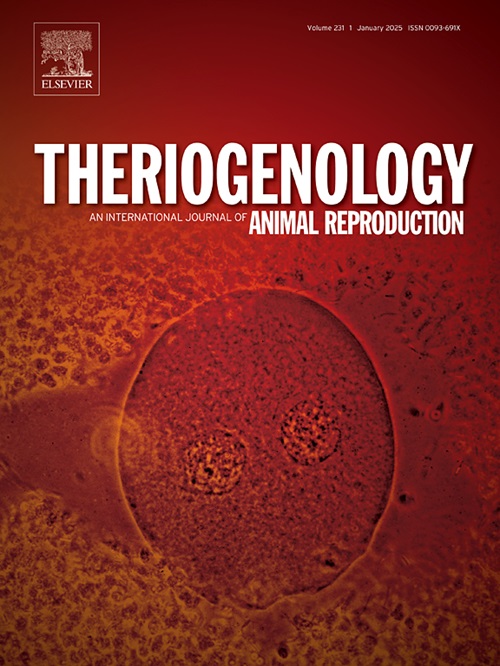Characteristics of porcine oocyte-cumulus complexes derived from various sizes of antral follicles and classified by brilliant cresyl blue staining, and developmental competence of the oocytes
IF 2.4
2区 农林科学
Q3 REPRODUCTIVE BIOLOGY
引用次数: 0
Abstract
The present study sought to determine the characteristics of porcine oocyte-cumulus complexes (OCCs) derived from very small and small antral follicles (with less than 1 mm and 1–3 mm in diameter, respectively; VSF and SF) in comparison with controls from medium ones (with 3–6 mm in diameter; MF). Additionally, the present study examined the utility of brilliant cresyl blue (BCB) staining for assessing these OCCs. The incidence of BCB- oocytes in VSF- and SF-derived OCCs was higher than that in MF-derived OCCs. Although the meiotic and developmental competences of BCB+ oocytes from MF were superior to those from VSF and SF, blastocysts were successfully obtained from BCB+ oocytes even derived from VSF. The mean numbers of both total and viable cumulus cells surrounding an oocyte were significantly affected not only by the origin of the OCCs, but also by the BCB status of the oocytes (largest in MF-derived OCCs containing BCB+ oocytes). Although the outer and inner diameters of zona pellucida were affected by the origin of OCCs and the BCB status of oocytes (largest in MF-derived oocytes), the ooplasmic diameter of BCB+ oocytes did not differ among those derived from VSF, SF, and MF. Regardless of the BCB status, the transcriptional levels of G6PD and TKT in cumulus cells decreased during follicular development from VSF to MF, whereas the RPIA mRNA level in cumulus cells of MF-derived BCB+ OCCs was lower than in the others. These results underscore the utility of BCB staining for selecting MF-, SF-, and even VSF-derived OCCs containing oocytes with relatively higher meiotic and developmental competences, as well as the importance of having a sufficient number of healthy cumulus cells expressing genes related to the pentose phosphate pathway at lower levels.
求助全文
约1分钟内获得全文
求助全文
来源期刊

Theriogenology
农林科学-生殖生物学
CiteScore
5.50
自引率
14.30%
发文量
387
审稿时长
72 days
期刊介绍:
Theriogenology provides an international forum for researchers, clinicians, and industry professionals in animal reproductive biology. This acclaimed journal publishes articles on a wide range of topics in reproductive and developmental biology, of domestic mammal, avian, and aquatic species as well as wild species which are the object of veterinary care in research or conservation programs.
 求助内容:
求助内容: 应助结果提醒方式:
应助结果提醒方式:


